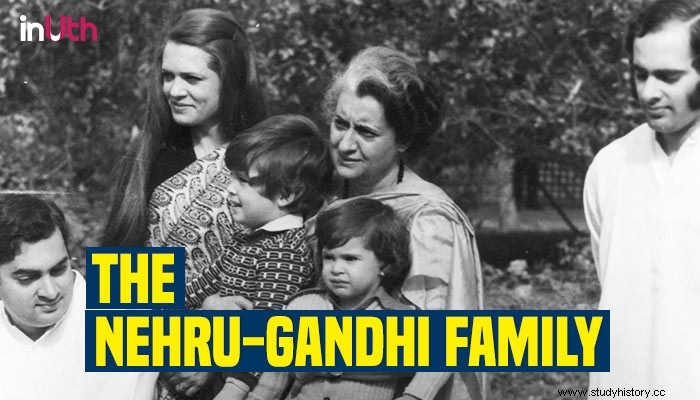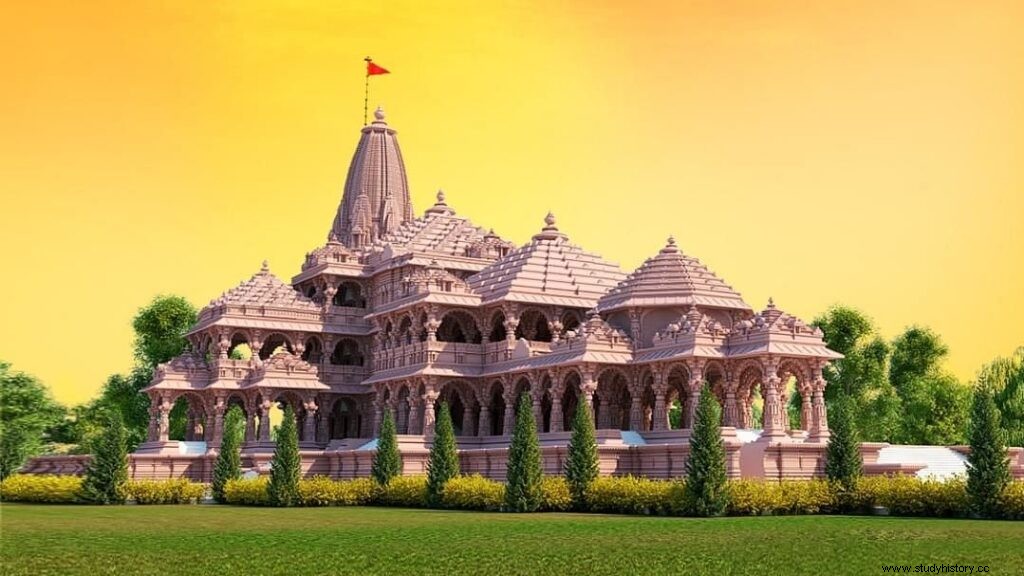India's stigma Babri demolition took place on 6th December, 1993
According to the local records available in India, regional history, legend and information available in Indian texts, the first credit for building a grand temple of Shri Ram at Shri Ram Janmabhoomi in Ayodhya goes to Kush, the eldest son of Maryada Purushottam Shri Ram. The excavation of Shri Ram Janmabhoomi by the Archaeological Survey of India revealed three layers of the temple, in which the second layer is believed to have been built by the great Chakravarti emperor Vikramaditya of the first BC. And about a thousand years later, in the eleventh-twelfth century, it was built or renovated by Govindchandra, the ruler of the Gahadwal dynasty of Ayodhya (source:Vishnuhari inscription excavated by ASI).
On the orders of Babur, his commander Mir Baqi destroyed this Shri Ram temple built in Ayodhya with a cannon on 21 March 1528. General Cunningham, the first chairman of the Archaeological Survey of India, has written that Mir Baqi did this work after killing 174,000 Ram devotees.
76 wars fought for Ram Mandir
According to the history obtained from traditional sources, 76 wars were fought for the return of Ram temple. Many times it happened when the claimant kings and fighters of the temple on the disputed site also held rights for some time but it could not remain permanent. The year the temple was demolished, a counter-military campaign was launched for the liberation of the temple under the leadership of Raja Mahtab Singh of nearby Bhiti princely state, Raja Ranvijay Singh of Hanswar princely state, Rani Jairaj Kunwari, Rajguru Pt. Devidin Pandey etc. He definitely distracted the royal army but could not cross it. During the reign of Humayun and Sher Shah between 1530 to 1556 AD, there is a mention of 10 wars in which thousands of Hindus got martyrdom.
On behalf of the Hindus, these wars were led by Rani Jayaraj Kunwari and Swami Maheshanand of Hanswar. Rani used to lead the female army and Maheshanand Sadhu used to lead the army. The strength of these wars can be gauged from the sacrifice of Rani and Maheshanand along with their soldiers. Between 1556 and 1605 AD, mention of 20 wars is also found during the reign of Akbar. In these wars, the saint Balramacharya of Ayodhya continued to fight as a general and eventually attained martyrdom.
The destructive policy of the Mughals continued
The result of these wars was that Akbar was forced to pay attention to this. Akbar, with the opinion of Birbal and Todarmal, gave permission to build a Ram temple on the platform in front of the Babri Masjid. The policies of Aurangzeb, a descendant of Akbar, were fundamentalist and it also affected the temple-mosque dispute. During his reign between 1658 and 1707 AD, many big Hindu temples including Kashi Vishwanath temple, Shri Krishna Janmabhoomi temple of Mathura were destroyed in which 30 times wars were fought for Ram temple. These wars were led by Baba Vaishnavdas, Kunwar Gopal Singh, Thakur Jagdamba Singh etc.
Contribution of Sikh Gurus for the liberation of Ramjanmabhoomi

It is believed that in these wars, the tenth Guru Gobind Singh had also sent Nihangs to fight for the liberation of Ram temple and except the last war, the Hindus got success in the rest. It is to be known that Guru Nanak, the first Guru of the Sikhs, had also visited the Ram temple in Ayodhya in 1510-11. Astu, during this period the temple supporters also occupied Ram Janmabhoomi for some time, but Aurangzeb attacked with full force and killed lakhs of Hindus and converted it into a mosque again.
The struggle continued even after the fall of the Mughals
By the middle of the 18th century, the Mughal power had declined, but the struggle for the temple continued. During the time of Wajid Ali Shah, the last Nawab of Awadh, between 1847-1857 AD, there is a mention of war twice under the leadership of Baba Uddhav Das. As a result, the Nawab constituted a commission consisting of a Hindu, a Muslim and an East India Company representative. The commission concluded that there was never a mosque there. The commission also told in its report that the structure built by Mir Baqi by demolishing the temple, it is clearly written on one of its stones that it is the site of the descent of the angels.
Anti-Hindu conspiracy by the British government
The effect of this was that the unity of Hindus and Muslims was established and the local Muslims of Ayodhya-Faizabad met and decided that the Muslims would give up the claim of the Babri Masjid for the Ram temple. When the British came to know about this, they hanged the founders of this campaign, Amir Ali and Baba Ramsharan Das, on a tamarind tree located at a distance of the disputed site, because the British rule worried about the united attack of Hindus and Muslims in the freedom struggle of 1857. Till then, to cut the united opposition of Hindu Muslims, Muslim appeasement had adopted the policy of divide and rule.
The British government built a wire fence at the disputed site in 1859 and allowed both Hindus and Muslims to offer prayers and prayers there, whereas before that prayers were never offered there as the Supreme Court has also written in its decision that before 1856. There is no evidence of prayer being offered there.
The beginning of the legal battle for the liberation of Ramjanmabhoomi
The legal battle for Ramjanmabhoomi began in 1813 AD when Hindu organizations claimed before the British authority that in 1528, on the orders of Babur, the temple at Ramjanmabhoomi was demolished and converted into a mosque. Therefore, Ramjanmabhoomi should be handed over to the Hindus in its entirety. After this, for the first time in the year 1885, during the British rule, Mahant Raghubar Das had sought permission to build the temple by petitioning the court.
Efforts to break the Babri structure during the British period
During the British era, an attempt was made to break the disputed structure again in 1934 under the leadership of Mahant Ramchandra Paramhans, in which only partially broke the disputed structure was successful. The British got it repaired again. After this, on 23 December 1949, Hindus started worshiping by placing a statue of Ramlala at the center of the structure. Since then the Muslim side stopped offering Namaz here and went to court.
Jawaharlal Nehru's conspiracy against Ramjanmabhoomi
Enraged by this, the evil Mohammad Jawaharlal Nehru ordered the Chief Minister of Uttar Pradesh, Govind Vallabh Pant, to remove the idols of Lord Shri Ram from the Ramjanmabhoomi and hand over the site completely as a mosque to the Muslims. The Chief Minister gave this order to the then District Magistrate of Faizabad. The District Magistrate reported that it is not possible to do so. If this is done then there can be terrible unrest and riots. Despite Nehru's lac pressure, District Collector KK Nair stuck to his point and maintained the status quo. In the meantime, Shri Gopal Singh Visharad filed a suit in the court and got the right to worship Hindus there in 1950 and the anti-Hindu Mohammad Nehru could not do anything.
Movement started for the construction of temple at Ramjanmabhoomi

Late Ashok Singhal, Late Mahant Ramchandra Paramhans, Yogi Adityanath's Guru Late Avadyanath, Shri Moropant Pingle, Shri Omkar Bhave, Shri Giriraj Kishore, Shri Lal Krishna Advani etc. In 1990, once again an attempt was made to wash the stigma of Babri, but the traitor Mullayam Singh Yadav took the lives of dozens of Ram devotees by firing bullets at Ram devotees. Freedom from the stigma of Babar, who pricked 100 crore Hindus and lakhs of virtuous souls who laid down their lives for Shri Ram Mandir, came after a great struggle on 6th December, 1992 in Shri Kalyan Singh Sarkar after 463 years while they were massacred by Ram Bhakts. Instead of giving permission, he accepted his resignation.
Nehru-Gandhi family conspiracy continues

Despite this, the obstacles of Shri Ram Mandir did not end. The Christian-Muslim Nehru-Gandhi family became the biggest obstacle in the construction of Ram temple. In the excavation of the Archaeological Survey, ASI member K.K. Of. Pressured Muhammad to lie and he was fired from the team for not lying. After the Supreme Court's decision, KK Muhammad said, "I did not even think that the decision would be so right. I feel relieved when I said that there was a Ram Mandir before the Masjid. Some people were after me."
It is known that in the excavation, ASI found evidence of a huge structure and continuous construction under the disputed land, which continued till the construction of the disputed structure. From there, carved bricks, couple fragmentary images of deities and carved architecture consisting of leaf clusters, amalka, kapotpali, door parts, lotus figures, circular places of worship which were probably Lord Shiva's temple etc. were found.
Not only this, these Christian-Muslim Nehru-Gandhi family gave an affidavit in the court to derail the verdict on Ram temple and declared Lord Shri Ram as fictitious. This article would be incomplete without discussing the heinous murder of 59 Ram Bhakts in Godhra, Gujarat. On 27 February 2002, Ram Bhakts who were sitting in S-6 bogie returning from Ayodhya by Sabarmati Express were surrounded by Muslim leaders of Congress and their supporters and started pelting stones in Godhra. To avoid stone pelting, when the Ram devotees closed the window, the entire bogie was set ablaze by the Muslims by pouring petrol, in which 59 Ram devotees were burnt to death.
Anti-India Leftist Historian
The traitor Nehruvian-leftist historians, raised by Nehru-Gandhi Khan Dan, also tried to divert the issue of Ramjanmabhoomi. Of the 15 historians presented by the Sunni Waqf Board, 12 were Hindus. Three Muslim historians were brokering their community and religion, there was no hope from them, but these 12 secular-left Hindu traitors also said that there was never a Ram temple in Ayodhya!
Witness No. 63 RS Sharma
Witness No. 64 Suraj Bhan
Witness No. 65 DN Jha
Witness No. 66 Romila Thapar
Witness No 72 BN Pandey
Witness No 74 R L Shukla
Witness No. 82 Sushil Srivastava
Witness No. 95 KM Shree Mali
Witness No. 96 Sudhir Jaiswal
Witness No.99 Satish Chandra
Witness No 101 Sumit Sarkar
Witness No 102 Gyanendra Pandey
The lie of leftist historians exposed
After the report of the Archaeological Survey of India, the lies of these traitors were exposed and they accepted in the Allahabad High Court that they had written the history of Ramjanmabhoomi sitting in their AC room and not on the facts. That is why the Allahabad High Court threw their historical documents in the dustbin as their personal views and not history. Leftist traitors of JNU also wrote 18 history texts and spread conspiracy lies to prove Ramayana period Ayodhya in Afghanistan and there is no temple on Ram Janmabhoomi which proved to be fake.
Supreme Court of India's verdict in favor of Ramjanmabhoomi

Even after this, the operatives of this anti-Hindu family tried a lot to hang the issue of Ramjanmabhoomi in the Supreme Court and to deviate, but the spartan Hindu society knew that even if the enemy could get away with lakhs, but all the evidence on Ramjanmabhoomi is in favor of Shri Ram Mandir, that's why it is. Whatever you do, one day the decision will definitely come in favor of Ram Mandir and this dispute which stings like a candle in the hearts of 100 crore Hindus will be resolved. On the historic day of September 9, 2019, we Hindus got success after a long struggle of 491 years. Today, the auspicious time for the reconstruction of Shri Ram Mandir at Ramjanmabhoomi in Ayodhya has come after a long struggle of 492 years. On August 5, 2020, Shri Ram Mandir Nirman Bhumi Pujanotsav took place and now the reconstruction work of Shri Ram Mandir has started. Greetings to all Indians!!
